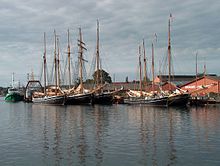Svendborg
[5] The first recorded mention of Svendborg occurred in 1229 in a deed of gift by Valdemar the Victorious, where he refers to the fortification as Swinæburgh.
Most historical facts about the medieval defense system, including the locations of fortifications, are disputed, as little archaeological evidence has been generated.
In spite of this, it is a popular theory that the three towers in the coat of arms are the three fortifications ("Skattertårnet", "Kyseborg" and a third one unnamed).
Ørkild Castle, located just east of Svendborg, was property of the bishop of Odense, who was less than popular among the citizens of the city.
The tension resulted in the castle being seized and burned down by an angry mob in collaboration with the King's forces.
In the following 250 years, the city faced various setbacks in its development, such as plague, a major fire, and the effects of the Swedish wars when Svendborg's ships were destroyed.
[5] It was not until the end of the war with the United Kingdom of Great Britain and Ireland and the Industrial Revolution in the early 19th century that the city returned to a period of increasing prosperity.
In the middle of the 19th century an explosion of industrialization happened, and all kinds of factories, from engineering to breweries were established together with modern gas and water systems.
[13] The rapid increase in population continued at the beginning of the 20th century as Svendborg developed into an even more important industrial and educational centre.
The port prospered with new facilities, including shipyards such as Svendborg Skibsværft which was established in 1907 on an artificial island.
Svendborg Sund approaches the town from the southwest, along which ferries coming from Ærøskøbing pass the smaller islands of Drejø, Hjortø, and Skarø.
[14] Several forested areas lie to the north-northwest of Svendborg, including Græsholmene, Løvehave, and Ravnebjerg Skov.
[15] The Mac Baren tobacco factory was established in Svendborg in 1887,[16] under the name Harald Halberg Tobaks and Cigarfabrik.
[18] Vor Frue Kirke (Church of Our Lady) located on a hill north of the market square was established in the 13th century but was enlarged in the late Middle Ages with a Gothic chancel, transepts and tower.
[21] Naturama, established in April 2005, is a natural history museum enhanced by means of various technological support features including light and sound, film, and expedition scenarios.









